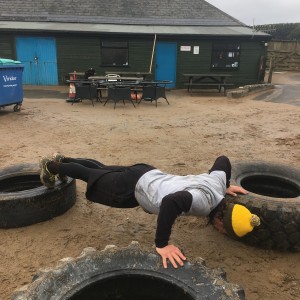Cross Country ski training on a beach in Devon
How do you train for a 90km cross country ski race in Sweden on a beach in Devon? Take your clothes off and try and ski down a sand dune at beach bootcamp?
Obviously training for something when you haven’t got the access to the conditions or the equipment is not easy. Similar to training to surf when you live in the city, all you can do is a needs analysis of the sport and try to mirror the movement patterns, fitness components, muscle groups and energy systems required. Any training program should be specific to the demands of the sport or reflect the specific needs/goals of the individual. Then a periodised program needs to progressively build up and then taper before the event in order to optimise energy levels, and mental/physical performance on the day. Training with a purpose gives you motivation. In personal training I find that as soon as someone has specific measurable goals to try and achieve within a certain time frame everything changes and they are driven to succeed.
“Cross country skiing uses just about every muscle in the body”
(Kris Freeman, cross country Olympian, 2016)
NEEDS ANALYSIS
- Good base of cardiovascular fitness. This event lasts approximately 10 hours so endurance is key. Combining Continuous, Interval, and fartlek sessions into training.
- Good muscular endurance in lower and upper body. (Poles and legs)
- Large compound exercises using big muscle groups together in an efficient way.
- Core strength to protect body, improve alignment and improve propulsion (efficiency of movement).
- Range of movement around the hip flexors, shoulders, thoracic spine. Increased range of movement = more power and less chance of muscle spasm/injury.
- Technique! efficiency of movement. Obviously this one cannot easily be achieved without the equipment and the snow!
PROGRAM – An example of a beach session based on the above needs analysis
Tyre flips 8 x 20 seconds with 10 seconds rest.
High intensity whole body movement using legs, upper body and core. (as is cross country skiing)
8 x 20 seconds deep press ups
Targeting upper body muscular endurance and engagement of core to ensure good alignment of the spine and help with 10 hours of propelling yourself with ski poles!
Core Blimey – Get up plus wall ball 8 x 10
Working the core dynamically again in an efficient , functional movement
Rope throws plus alternate foot step. 3 x 1 minute plus plank active recovery.
To mimic the physical demands and movement patterns of cross country skiing on the shoulders, hip flexors and legs.
Sumo High Pull plus calves 3 x 20
As cross country skiing involves a lot of plantar and dorsi flexion the calves need to be strong and mobile through the gastrocnemius and deeper into the soleus. Rarely in life do we use the calves in isolation so I like to incorporate them into large functional movements.
A good active recovery wall stretch for the calves in between sumo high pull sets.
Firstly work into the Gastrocnemius by pressing back heel into the ground for 30 seconds. Then work deeper into the soleus muscle by bringing front knee to wall as long as your front heel stays down and repeat movement for 30 seconds.
Core Blimey – Get up plus wall ball 8 x 10
Working the core dynamically again in an efficient , functional movement
Dune sprints 6, 8, or 10 dune sprints with slow walk back down.
Working at high intensity to condition the body to be able to work at these intensities for longer before the Onset of Blood lactate. Recent research suggests that working for 30 seconds as hard as you can initiates the production of EPO naturally which is the hormone that Lance Armstrong illegally injected himself with for years.
Plank walks 1 minute.
Walk elbows forward and then back. Maintaining good alignment to strengthen and protect body.
Finish up with a low intensity run (20 mins) and some restorative stretching to release tension in posterior chain (calves, hamstrings, glutes, lumbar spine, QL (side bends), thoracic spine, shoulders) and anterior chain (Quads, hip flexors, shoulders)


